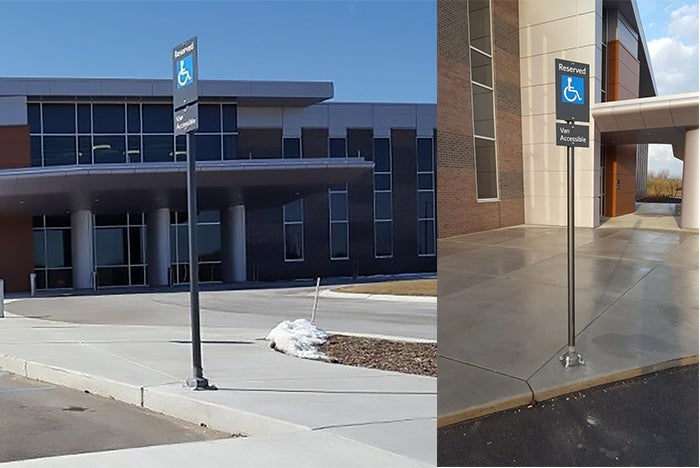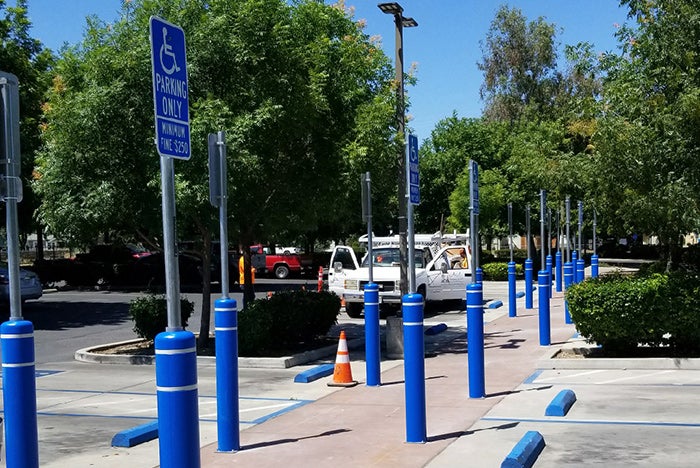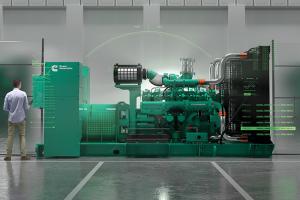Advice on parking signage systems

Heavy-duty flexible signposts at a Michigan health care facility.
Photo courtesy of John Kandra
The challenge of directing parking lot traffic and keeping patients and visitors safe has become increasingly important. Hospitals and other types of health care facilities are now struggling with a multitude of parking lot challenges. As traffic tends to be moving in and out of these lots on an almost continuous basis transporting patients, staff, providers, visitors, vendor deliveries, emergency vehicles, security shuttles, passenger drop off and more, parking anxiety is at an all-time high.
In addition to stress, traffic congestion can lead to other disruptions, including lost time as drivers are forced to stay in their vehicles longer or drive around looking for a place to park. As a solution to orienting traffic flows in and out of tight parking spaces, many signage and wayfinding alternatives must be employed.
Curbside care
Over the course of the COVID-19 pandemic, many health care facilities have made the move toward a curbside model of patient care. Examples of drive-up care include flu shots and other vaccinations, blood pressure checks, B12 injections and strep tests.
In addition, to further support safe social distancing, there has been a reduction in the use of waiting rooms in ambulatory and hospital locations. This is being accomplished through enhanced pre-registration workflows and virtual check-ins upon arrival. Patients who use the virtual waiting room stay in their vehicle until notified that it is time to enter the building. This increases the need for signage and well-designated parking spaces.
While the parking lot has often been an afterthought in the past, it is now becoming much more important as the parking space, signage, phone/app and car-side staff interaction may be the sum of a patient’s experience with an organization.
Importance of appearance
Additionally, with physicians, nurses, hospital staff, security personnel and patients coming and going every day, it is crucial to have proper parking signage displayed.
Bent, damaged, missing or destroyed signposts are also a hazard and a risk to Americans with Disabilities Act (ADA) compliance. Also, many hospitals are required to have designated zones, directional signage and safety areas, which require the implementation of signposts ranging from ultra-portable to semi-permanent.
Appearance is also important in health care. Well-maintained facilities, consistent brand messages and clear direction/navigation for patients and visitors is critical.
Portable solutions
Today’s health care facility parking lots often require the ability for quick deployment or to reconfigure the lot at a moment’s notice. Examples of this type of application include COVID-19 drive-up testing, flu shots, emergency helicopter landings, inbound disasters or emergency medical vehicles, security or fire closings, and more.
Some portable signposts feature an 18-pound, turn-and-lock rubber base that can be moved at a moment’s notice. A desirable feature available in some portable signposts that provides an added measure of safety includes an internal spring that offers 360 degrees of flexibility upon impact.
These often bear the name of channelizer posts, guide posts or delineator paddles. Delineator paddles usually offer the ability to include a message in the form of a label, which can be customized based on the specific application.
Semi-permanent signposts
Parking lots with heavier traffic patterns often require a more durable bollard/signpost solution because the post is impacted more often by vehicles. Many times, these heavily traversed lots are reserved for physicians, nurses and other staff who are coming and going in the dark of night or other adverse conditions.

Flexible bollards with signposts for an ADA-compliance installation.
Photo courtesy of A & A Restriping LLC
As mentioned previously with regard to the portable signpost solutions, the ability for the bollard/post to flex is desirable. This protects the vehicle and minimizes damage to the sign, post and lot itself.
Historically, core-drilled bollards with signposts had their place in protecting the entryway to a facility, HVAC equipment and similar elements. However, because they do not flex, they are not the ideal solution for parking space signage because damage can be caused to both the vehicle and the parking lot upon impact. New technology is replacing this type of post with safer, more durable alternatives.
When a patient’s vehicle is involved in a collision with a core-drilled bollard, they most likely will no longer be entering your facility that day and receiving care, due to distress caused by the accident. A costly repair may also be required for the customer’s vehicle, and possible litigation could result.
Additionally, damage to the parking lot can be costly. An average core-drilled bollard repair or replacement can easily cost up to $1,250 for each occurrence. This does not include the issue of the customer’s vehicle repair costs.
Fortunately, there are flexible heavy-duty signpost and bollard solutions that are more cost effective and can be easily installed in 30 minutes or less by simply using a hammer-drill and a wrench. This avoids the expense of heavy equipment and several hours of labor, mixing of concrete and, often, cordoning off the parking lot.
Branding opportunities
A hospital’s parking lot has also been playing an increasingly larger role in influencing the patient’s experience and perception of that organization’s brand image. As more customers opt for curbside care and are no longer entering the facility itself, the opportunities to communicate with or influence the customer continue to diminish.
This creates a necessity for delivering on the brand image where the patient will be spending their time — that is, waiting in their vehicle while temporarily parked in a reserved space.
Recent innovations have created opportunities for branding. Parking lot bollards can be customized to match virtually any color, and corporate logos can be added. This serves to both provide a consistent image and to differentiate the facility from the competition.
Bollard and signpost height, number of sign brackets (and number of signs per post) also can be specified, providing opportunities for a variety of parking lot signage applications.
ADA compliance
All facilities, both private and public, are required by law to follow federal ADA guidelines. ADA access signs need to be posted at properly designated accessible parking spaces. These accessible parking spaces must be identified by signs that include the International Symbol of Access.
Signs at van accessible spaces must include the additional phrase, “van accessible.” Federal specifications for ADA signage also requires that the bottom edge of the sign must be more than 5 feet from the ground. In addition, the size of the accessibility parking sign must not be smaller than 12 by 18 inches.
While design specifications for accessibility parking signs is consistent at the federal level, requirements for ADA signage can vary by state. Each state also may have supplemental sign requirements. Supplemental ADA parking signs are typically placed under the larger accessibility reserved parking signs.
Because it is important to maintain ADA compliance, the appropriate signpost should be at least 8-feet high for visibility. The base of the signpost must be able to support the size and weight of an ADA sign, and multiple signs if required.
Opportunity for organizations
Parking lots for hospitals and other health care facilities have become much more chaotic with the COVID-19 pandemic and resulting move toward a curbside model of care and virtual waiting rooms. However, this also presents an opportunity for organizations to differentiate themselves from the competition by making life easier and less stressful for patients, staff and the many other types of visitors creating 24/7 traffic congestion in parking lots.
Flexible signpost solutions are recommended for busy health care parking spaces, whether for wayfinding, curbside care, ADA or other types of reserved spaces. This recommendation is based on their durability, ease of installation, increased safety, cost savings and capabilities for organizational branding.
Jeremy Johnson is marketing coordinator at FlexPost Inc., Holland, Mich. For more information, visit FlexPost's website.




